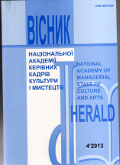Charles Didlo as a teacher of dance: master’s testament
DOI:
https://doi.org/10.32461/2226-3209.4.2013.138028Keywords:
classical dance, dance pedagogics, ballet, school of classical danceAbstract
The article represents the problem of forming the pedagogical method and the principles of educating ballet dancers. Characteristic features of Ch. Didlo’s professional activity in the process of establishment of Russian school of classical dance are disclosed. J.J. Nover’s as well as his compatriots’ activity fostered the appearance of a new dancing movement technique which was quantitatively and qualitatively more abundant than before being reformed. This resulted in the creation of an invincible block of professionalism and technical difficulties between a new type of dancer and amateur. The burden of these changes, which had been completed by the beginning of the 19th century in Western Europe, lay in St. Petersburg on Ch. Didlo’s shoulders who was then in charge of the ballet and the leading teacher of the school. Ch. Didlo was the one who introduced a new approach to the spectacle of dance into the dancing canvas of the 18th and early 19th century. An important achievement of Ch. Didlo as a choreographer was poetical integrity and completeness of plays. He promoted the role of corps de ballet having turned it from passive background into the active participant which "accompanied" soloists. Didlo’s dance underwent dramatic transformations due to the influence of choreographic lore on Russian territory. Among Didlo’s votaries was G. Derzhavin, A. Gryboyedov, A. Pushkin who left behind their inspired poetical lines and accurate observations of Didlo’s art and Russian ballet of that period. Under Didlo’s guidance Russian ballet gained recognition on the European scale. Didlo was not only an outstanding ballet-master but also a teacher of dance. The first Russian school of classical dance had been shaped in the three decades of Didlo’s life, devoted to Russian theatre and teaching activity. Being aware of the importance of reforming the school of ballet Didlo took up its reformation with huge feedback refusing to stage big new ballets by the time the school of dance would appear. Among the first actors who graduated from it was A. Glushkovskyy, M. Golts, E. Kolosova, M. Danylova, A. Istomina, K. Teleshova, A. Likhutina and many other dancers who had formed under his guidance and lauded Russian ballet. Didlo claimed from his students that the flight should startle his contemporaries. He achieved this by the means of "half-finger" technique and moving "elevational" tempos which combine various movements into a single dancing element. Didlo must have introduced arabesque, a future plastic leitmotiv of romantic and later of Russian ballet, into adagio earlier than his western colleagues. In Didlo’s ballets like in stagings of first masters of romantic ballet prevail those movements which constitute the prerogative of today’s feminine dance. It should be mentioned that the versatility of jumping movements in Didlo’s ballets used to be much more vivacious than nowadays. Though this advantage was created with simplest movements, now undeservedly forgotten. The term pas de deus, existing already in the 18th century, used to define any couple dance. And no sooner than the 1820s, starting with the period of Didlo’s artistic maturity, his gradual development could be seen, mostly the setting of through gaming objective. Support in Didlo’s ballets existed in such a form where it’s justified by the action basis of the dance performance or pantomime episode. Alongside exposing acrobatic moments new techniques of support would be born as a result of searching for acute plot and scenic dancing points (accents) etc. Didlo put in the first place the actors who tended not to differ in rich dancing techniques and used to dance what is now called typical dances. The explanation for this is provided by the fact that in an entertaining, divertissement play, meeting the demand of the audience, the conflict between the actor who acted as a meaningful character from the ballet play and the whole scenery was inevitable. Thus there were large discrepancies between Didlo’s traditions and the principles pertaining to the basis for Russian ballet of 1860s – 1879s. Didlo craved for the convincing performance in general. He achieved the feedback from the audience on scenic features of the portrayed characters: emotions of anger, compassion, fear and pity. In such circumstances mimes were of greater to him than famous dancers. Summing up the significance of Ch. Didlo’s artistic activity in the history of Russian ballet, his immense achievements in the sphere of choreographic education and formation of the ballet company should particularly be mentioned. Three decades of enthusiastic work of the ballet-master in Russia contributed to the renewal of the school of classical dance. Its quantity increased in several times, it stood on its own feet and turned into the educational mechanism, not only capable of refunding the shortage of ballet actors at large but of forcing foreign female dancers out of Russian scene. In the school Ch. Didlo lay the solid foundation of classical dance of the 19s century, the concern to be later carried on under the guidance of M. Petipe.Downloads
Published
Issue
Section
License
Authors who publish with this journal agree to the following terms:
1. Authors retain copyright and grant the journal right of first publication with the work simultaneously licensed under a Creative Commons Attribution License International CC-BY that allows others to share the work with an acknowledgement of the work's authorship and initial publication in this journal.
2. Authors are able to enter into separate, additional contractual arrangements for the non-exclusive distribution of the journal's published version of the work (e.g., post it to an institutional repository or publish it in a book), with an acknowledgement of its initial publication in this journal.
3. Authors are permitted and encouraged to post their work online (e.g., in institutional repositories or on their website) prior to and during the submission process, as it can lead to productive exchanges, as well as earlier and greater citation of published work (See The Effect of Open Access).


